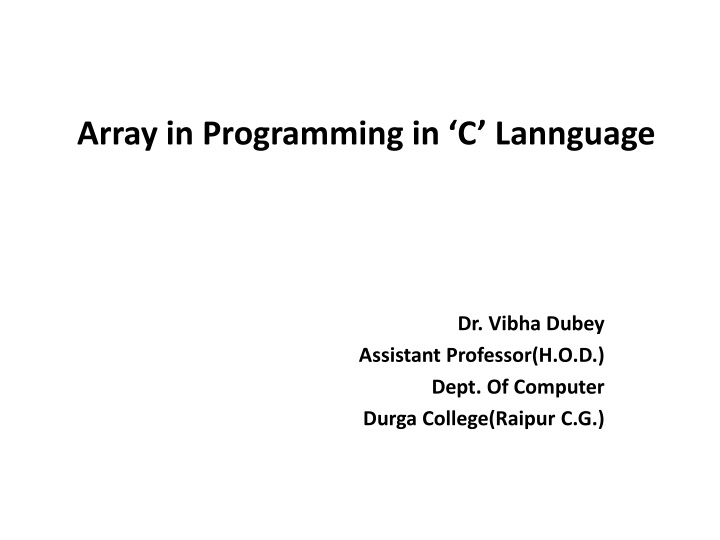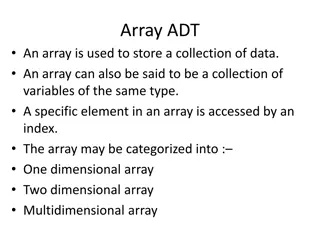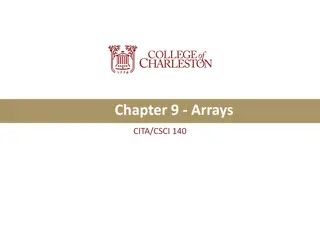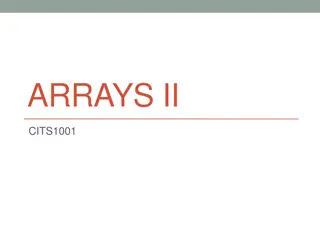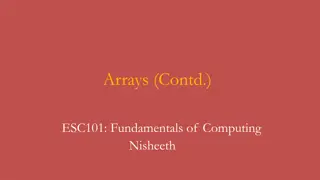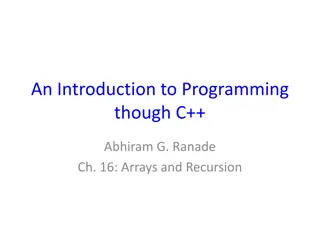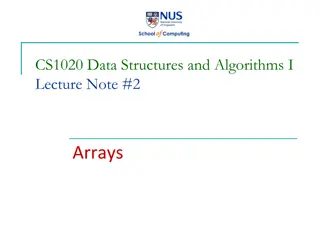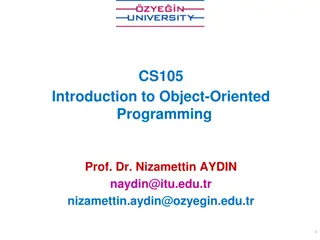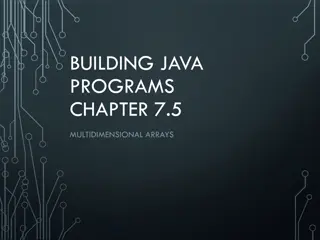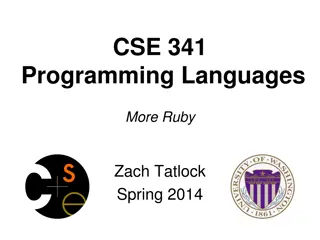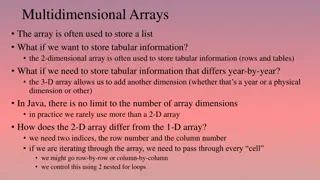Introduction to Arrays in Programming in C Language
Arrays in programming in C language are essential data structures for storing collections of similar data types in contiguous memory locations. Learn about the declaration, initialization, and accessing of arrays, along with their advantages and various dimensions like one-dimensional and multi-dimensional arrays. Dive into the syntax, elements, and memory allocation of arrays to enhance your programming skills and efficiency.
Download Presentation

Please find below an Image/Link to download the presentation.
The content on the website is provided AS IS for your information and personal use only. It may not be sold, licensed, or shared on other websites without obtaining consent from the author.If you encounter any issues during the download, it is possible that the publisher has removed the file from their server.
You are allowed to download the files provided on this website for personal or commercial use, subject to the condition that they are used lawfully. All files are the property of their respective owners.
The content on the website is provided AS IS for your information and personal use only. It may not be sold, licensed, or shared on other websites without obtaining consent from the author.
E N D
Presentation Transcript
Array in Programming in C Lannguage Dr. Vibha Dubey Assistant Professor(H.O.D.) Dept. Of Computer Durga College(Raipur C.G.)
INTRODUCTION Array is the collection of similar data types or collection of similar entity stored in contiguous memory location. Array of character is a string. Each data item of an array is called an element. And each element is unique and located in separated memory location. Each of elements of an array share a variable but each element having different index no. known as subscript. An array can be a single dimensional or multi-dimensional and number of subscripts determines its dimension. And number of subscript is always starts with zero. One dimensional array is known as vector and two dimensional arrays are known as matrix. ADVANTAGES: array variable can store more than one value at a time where other variable can store one value at a time.
DECLARATION OF AN ARRAY : Its syntax is : Data type array name [size]; int arr[100]; int mark[100]; int a[5]={10,20,30,100,5} The declaration of an array tells the compiler that, the data type, name of the array, size of the array and for each element it occupies memory space. Like for int data type, it occupies 2 bytes for each element and for float it occupies 4 byte for each element etc. The size of the array operates the number of elements that can be stored in an array and it may be a int constant or constant int expression.
INITIALIZATION OF AN ARRAY One Dimentional Array After declaration element of local array has garbage value. If it is global or static array then it will be automatically initialize with zero. An explicitly it can be initialize that Data type array name [size] = {value1, value2, value3 } Example: in ar[5]={20,60,90, 100,120} Array subscript always start from zero which is known as lower bound and upper value is known as upper bound and the last subscript value is one less than the size of array. Subscript can be an expression i.e. integer value. It can be any integer, integer constant, integer variable, integer expression or return value from functional call that yield integer value.
ACCESSING OF ARRAY ELEMENT: /*Write a program to input values into an array and display them*/ #include<stdio.h> int main() { int arr[5],i; for(i=0;i<5;i++) { printf( ( %d\t ,arr[i]); } return 0; } OUTPUT: Enter a value for arr[0] = 12 Enter a value for arr[1] =45 Enter a value for arr[2] =59 Enter a value for arr[3] =98 Enter a value for arr[4] =21 The array elements are 12 45 59 98 21 Example: From the above example value stored in an array are and occu
Example: From the above example value stored in an array are and occupy its memory addresses 2000, 2002, 2004, 2006, 2008 respectively. a[0]=12, a[1]=45, a[2]=59, a[3]=98, a[4]=21 ar[0] ar[1] ar[2] ar[3] ar[4] 12 45 59 98 21 2000 2002 2004 2006 2008
Two dimensional arrays Two dimensional array is known as matrix. The array declaration in both the array i.e.in single dimensional array single subscript is used and in two dimensional array two subscripts are is used. Its syntax is name[row][column]; Or we can say 2-d array is a collection of 1-D array placed one below Total no. of elements in 2-D array is calculated as row*column the other Example: int a[2][3]; Total no of elements=row*column is 2*3 =6 It means the matrix consist of 2 rows and 3 columns Data-type array
For example: 20 2 7 8 3 15 Positions of 2-D array elements in an array are as below 00 01 02 10 11 12 a [0][0] a [0][0] a [0][0] a [0][0] a [0][0] a [0][0] 20 2 7 8 3 15 Accessing 2-d array /processing 2-d arrays For processing 2-d array, we use two nested for loops. The outer for loop corresponds to the row and the inner for loop corresponds to the column. For example int a[4][5]; for reading value: 53
for reading value: for(i=0;i<4;i++) { for(j=0;j<5;j++) { scanf( %d ,&a[i][j]); } } For displaying value: for(i=0;i<4;i++) { for(j=0;j<5;j++) { printf( %d ,a[i][j]); } }
Initialization of 2-d array: 2-D array can be initialized in a way similar to that of 1- D array. for example: Int mat[4][3]={11,12,13,14,15,16,17,18,19,20,21,22}; These values are assigned to the elements row wise, so the values of elements after this initialization are Mat[0][0]=11, Mat[1][0]=14, Mat[2][0]=17 Mat[3][0]=20 Mat[0][1]=12, Mat[1][1]=15, Mat[2][1]=18 Mat[3][1]=21 Mat[0][2]=13, Mat[1][2]=16, Mat[2][2]=19 Mat[3][2]=22
While initializing we can group the elements row wise using inner braces. for example: Int mat[4][3]={{11,12,13},{14,15,16},{17,18,19},{20,21,22}}; If we initialize an array as int mat[4][3]={{11},{12,13},{14,15,16},{17}}; Then the compiler will assume its all rest value as 0,which are not defined. Mat[0][0]=11, Mat[1][0]=12, Mat[2][0]=14, Mat[3][0]=17 Mat[0][1]=0, Mat[1][1]=13, Mat[2][1]=15 Mat[3][1]=0 Mat[0][2]=0, Mat[1][2]=0, Mat[2][2]=16, Mat[3][2]=0 In memory map whether it is 1-D or 2-D, elements are stored in one contiguous manner.
